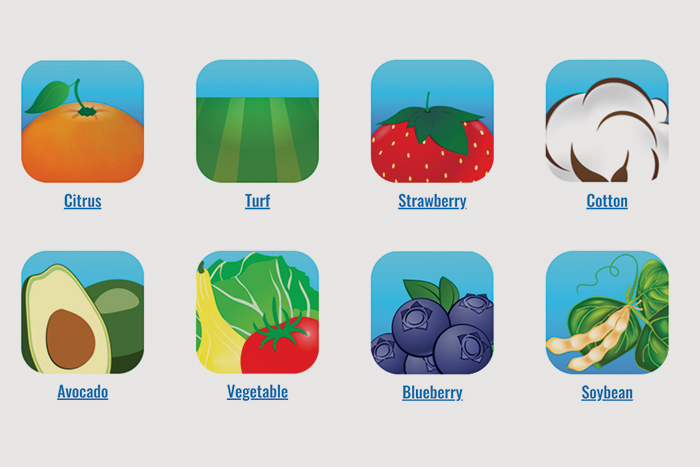
Effective irrigation management requires reliable, easy-to-use and affordable techniques to support real-time scheduling to achieve optimal plant growth and yield while ensuring efficient use of freshwater resources and reducing agricultural environmental challenges. Technological advances in the last two decades allow growers and water managers to adopt computer- and smartphone-based solutions to optimize irrigation scheduling. Several available web-based irrigation scheduling tools have been developed for multiple cropping systems and irrigation systems by integrating near real-time and projected weather data with crop information for crop water use (e.g., crop evapotranspiration, ETc) and using the water balance model for irrigation scheduling. Although the web-based irrigation scheduling tools provide valuable sources of information with an attractive interface, their adoption has been limited due to less user-tool interaction where the users require periodic use of a desktop or laptop to manage irrigation. Contrary to that, smartphone-based irrigation scheduling apps provide greater flexibility, offer continuous user-tool interaction, an intuitive interface, and provide near real-time irrigation information on the go.
Technological advances in the last two decades allow growers and water managers to adopt computer- and smartphone-based solutions to optimize irrigation scheduling.
For the last decade, a team of researchers from the University of Florida and the University of Georgia has been leading the development, testing, validation and implementation of a suite of easy-to-use smart irrigation apps for different crops including citrus, strawberry, cotton, avocado, vegetables, blueberry and soybean with field and sweet corn and peach apps currently being under development (see fig. 1). These apps were developed with the central goal of providing real-time irrigation scheduling recommendations for users. The apps are freely available for use and can be downloaded through the iOS and Android stores. A full suite of smart irrigation apps is available online at smartirrigationapps.org. These apps leverage the available networks of weather stations through the Florida Automated Weather Network and the Georgia Automated Environmental Monitoring Network.
Most of the commercially available irrigation scheduling apps were designed to use with minimum input from the users. For example, most of the smart irrigation apps developed for field crops require inputs including location selection using a map or list interface, basic crop and irrigation system information including planting date and expected harvest date, and irrigation system efficiency. Many apps allow automatic selection of the nearest automated weather station and soil information based on the area of interest and location selection. Other apps allow the selection of only automated weather stations as selectable options. Once these options are selected, the app automatically uses the climate data for ETc calculation and populates with the default value of crop information (e.g., crop coefficient, rooting depth) and soil waterholding characteristics. These inputs are further used to track and display the soil water content and soil water deficit using different graphical interfaces including conceptual bucket diagrams and gas gauges. Many apps use notifications via text message or email to alert users to promote irrigation scheduling changes that reflect plant water needs on a real-time basis.
Contrary to irrigated scheduling apps for field crops, additional inputs are required for specialized and tree crops such as tomatoes, avocados, strawberries, citrus, etc., including row spacing, bed spacing, irrigation system flow rate and other related variables. For vegetable crops, many apps do not account for rainfall and soil data as these cropping systems are operating under drip irrigation systems and raised-bed plastic mulch. The final irrigation schedule from these apps provides information on the irrigation system run time per day rather than soil water content and soil water deficit. Most of the apps such as the avocado app and the cotton app have been evaluated under different field and environmental conditions. The apps have resulted in significant improvements in crop water use efficiencies and water conservation compared to conventional irrigation scheduling methods.

Overall, smartphone irrigation scheduling apps provide an easy way to determine your irrigation schedule for different crops and come with the flexibility of making user-specific customization, including water savings, irrigation event schedules and notifications. For example, many apps allow users to modify the estimated soil water content using the measured soil moisture data from soil moisture sensors. Apart from the many benefits, currently there are no available options to fully integrate these apps with irrigation systems to achieve a fully automated closed-loop feedback system for irrigation scheduling options. As a result, users are expected to input app recommendations regarding irrigation application depth or run time into their irrigation control systems.
In addition, another major limitation that affects the effectiveness of these apps in accurately calculating irrigation schedules for maximum irrigation water use efficiency is spatial variability of rainfall and other climate variables and the availability of accurate site-specific soil information. With the continuous advancement of technology and artificial intelligence solutions, the future of irrigation scheduling apps will more likely include different types of data that are seamlessly integrated such as remote sensing data including drone and satellite imagery, historical information and climate projections, and high-resolution gridded weather data. Using these in conjunction with crop models would benefit irrigation water management.
8280 Willow Oaks Corporate Drive | Suite 630 | Fairfax, VA 22031
Tel: 703.536.7080 | Fax: 703.536.7019
HOME | ABOUT US | ADVERTISE | SUBSCRIBE | CONTACT | PRIVACY POLICY | IA ANTITRUST STATEMENT